Don M. Winn's Blog, page 18
November 3, 2016
The Gift of a Great Story!
As we approach the end of another year, and people start thinking about gifts for their loved ones, I’m always amazed by all the new, ever-more-sophisticated toys I see advertised. Don’t get me wrong, I’m not against sophisticated toys…there may even be a few that I wouldn’t mind checking out. But when I think back on my childhood, it’s not the toys I remember; it’s the love of a great story—in other words, books.
How can a toy compare to having your favorite story read to you every night by a parent, or in my case, my grandmother? It’s the stories I loved as a child, the adventures I lived in my imagination, that I still think about today. What about the child in your life? There can be no greater gift you can give to your child than that of your time and of sharing great stories together.
Cardboard Box Adventures books make great gifts for even the most reluctant young readers. When you give a CBA book to a child, you are also giving them some of yourself as you take the time to read the books aloud together and talk about what you’ve read. Check out the list of available CBA books below.
The Sir Kaye Chapter Book Series
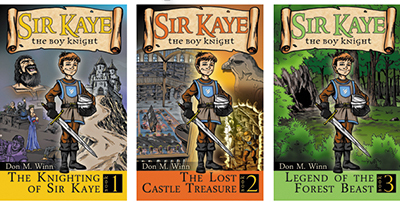
The award-winning Sir Kaye the Boy Knight® chapter books (for ages 8 and up) follow the adventures of young Kaye Balfour and his best friends. This warmhearted, humorous adventure series shows how a twelve-year-old in the medieval land of Knox is knighted, becomes the most famous knight in the country, and has adventures as he strives to be a loyal and true knight.
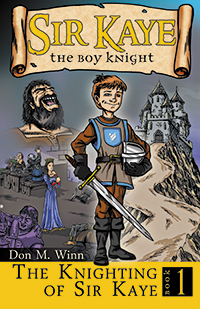 The Knighting of Sir Kaye (K1): Kaye Balfour and his best friend Reggie live during the Middle Ages in the fictional country of Knox. Together they have adventures, deal with bullies large and small, and try to help the inexperienced young queen start getting her damaged kingdom back on its feet.
The Knighting of Sir Kaye (K1): Kaye Balfour and his best friend Reggie live during the Middle Ages in the fictional country of Knox. Together they have adventures, deal with bullies large and small, and try to help the inexperienced young queen start getting her damaged kingdom back on its feet.
2013 IndieReader Discovery Award
2013 Moonbeam Children’s Book Award Silver
2013 UK Wishing Shelf Book Award Silver
2014 Storyteller’s Campfire Voyager Marble Award
“Fortitude, good will, and friendship triumph over pettiness in this enjoyable story.”—Publishers Weekly
“A fantastic, fun-filled adventure. Highly recommended.”
—The UK Wishing Shelf Book Awards
“An excellent start to a fine medieval adventure series for young children, readable and entertaining.”—IndieReader Review
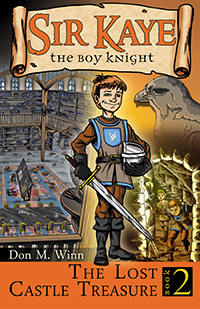 The Lost Castle Treasure (K2): Between the stone walls of Knox Castle lie many secrets—some even deadly. For Kaye, the boy knight, and his young friends, Reggie and Beau, the castle, along with the young Queen Vianne, provides a new home and a promising future.
The Lost Castle Treasure (K2): Between the stone walls of Knox Castle lie many secrets—some even deadly. For Kaye, the boy knight, and his young friends, Reggie and Beau, the castle, along with the young Queen Vianne, provides a new home and a promising future.
A Mom’s Choice Awards Gold Medal Recipient
2014 Wishing Shelf Book Awards Finalist
2015 Readers’ Favorite Book Award Finalist
2015 Foreword Reviews IndieFab BOTY Award Finalist
“A fun, exciting adventure. Sir Kaye is a fantastic role model for kids.”—The UK Wishing Shelf Awards
“A fun and easy way to teach kids about loyalty, trust, perseverance, patience and other important life values…a definite five-star children’s story.” —Faridah Nassozi for Readers’ Favorite
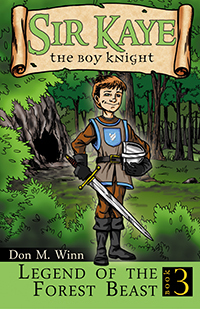
Legend of the Forest Beast (K3): Kaye, Reggie, and Beau set out on a quest to find Layla’s kidnapped father. Vanishing sheep, rumors of a mysterious beast, and one very determined girl make this an adventure of a lifetime.
A Mom’s Choice Awards Gold Medal Recipient
2016 Silver Moonbeam Children’s Book Award
“A cracking, fun-filled adventure. Highly recommended!” —The UK Wishing Shelf Awards Book Review
“Legend of the Forest Beast captures colorful adventures, fun characters, and inspirational thoughts in a quick and easy read for children.” —IndieReader Review
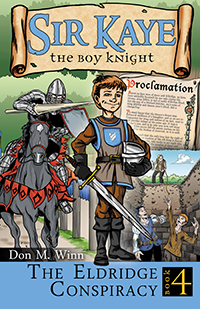
The Eldridge Conspiracy (K4): Kaye enters Eldridge alone to seek the only man who can tell him how to save his father’s life.
Look for The Eldridge Conspiracy in 2017
CBA Picture Books

CBA picture books (for ages 3-8) are designed for parents, grandparents, relatives, teachers, caregivers, and friends to read aloud with children. Your child, niece, nephew, grandchild, or student will long appreciate and remember the time you spend with them.
Each book has a fun teaching theme that parents can use to illustrate important life lessons as well as questions for discussion. For a list of topics contained in each CBA book check out the Lesson Reference Guide.
“I love Cardboard Box Adventures Books because they not only teach valuable lessons, but they do so in a manner that will last throughout a lifetime.”
—Family Review Center
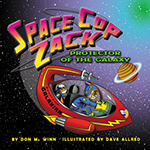
Space Cop Zack, Protector of the Galaxy: A young boy uses his imagination to turn his backyard playtime into an adventure across the galaxy. A great book for the adventurous child in your life! (Or the kid who has everything.)
2015 UK Wishing Shelf Book Award GOLD
Readers’ Favorite Book Award Winner
Mom’s Choice Award Recipient
Family Review Center Seal of Approval
“The author does a fantastic job of capturing a little boy’s imagination…If you are looking for a funny, fun, and entertaining book for your child’s library…pick up a copy and see for yourself what a great book this is.” —Readers’ Favorite Review
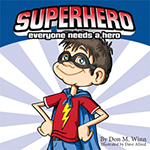 Superhero: In Superhero, a little boy learns who life’s real superheroes are… A tear-jerking story about the special bond between father and son.
Superhero: In Superhero, a little boy learns who life’s real superheroes are… A tear-jerking story about the special bond between father and son.
Mom’s Choice Award Recipient
2014 Family Review Center Gold Medal
2014 Family Review Center Best of the Year
2014 Readers’ Favorite 5 Star Review
“The story; a mere 15 pages long. The lessons learned by reading this story; endless and invaluable…” —Family Review Center
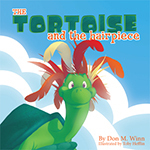 The Tortoise and the Hairpiece: An innovative turtle learns that true friends love him for who he is inside, not what he looks like. Everyone can identify with adorable character Jake the Tortoise’s desire to be accepted by others.
The Tortoise and the Hairpiece: An innovative turtle learns that true friends love him for who he is inside, not what he looks like. Everyone can identify with adorable character Jake the Tortoise’s desire to be accepted by others.
A Mom’s Choice Award Recipient
“The Tortoise and the Hairpiece is just the ticket for young children who are exploring their own identities and discovering differences…”—Midwest Book Review
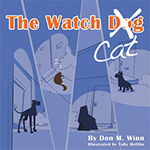 The Watch Cat: An ordinary cat becomes a neighborhood hero by saving his house from a burglar. A fun and unique story that will appeal to every cat lover!
The Watch Cat: An ordinary cat becomes a neighborhood hero by saving his house from a burglar. A fun and unique story that will appeal to every cat lover!
A Mom’s Choice Award Recipient
“A fun, lyrical book that is easy to read, easy to follow, and as fun for the kids to read or listen to as it is read to them…” —The IE Mommy, Christine
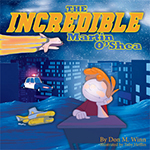 The Incredible Martin O’Shea: Martin learns that by paying attention in school, he can make his dreams come true. An enjoyable read for everyone, but especially kids with big imaginations!
The Incredible Martin O’Shea: Martin learns that by paying attention in school, he can make his dreams come true. An enjoyable read for everyone, but especially kids with big imaginations!
A Mom’s Choice Award Recipient
“A wonderful bedtime story that will help children to learn the necessity of imagination and education…” —The IE Mommy, Christine
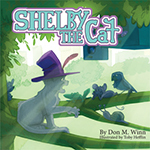 Shelby the Cat: A kind cat named Shelby resists bullying and peer pressure by staying true to what matters most to him. An engaging story that encourages young ones to stay true to themselves!
Shelby the Cat: A kind cat named Shelby resists bullying and peer pressure by staying true to what matters most to him. An engaging story that encourages young ones to stay true to themselves!
A Mom’s Choice Award Recipient
“A story of courage and strength…Shelby doesn’t give in to the bullying and peer pressure. And best of all, his good deeds come back to him in the form of friends’ support, a wonderful reward for living a life that is generous to others.” —Nancy O. Nelson, PhD.
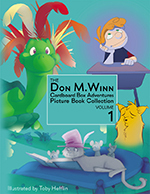 The Don M. Winn Cardboard Box Adventures Picture Book Collection Volume One: Four great Cardboard Box Adventures picture books in one volume!
The Don M. Winn Cardboard Box Adventures Picture Book Collection Volume One: Four great Cardboard Box Adventures picture books in one volume!
Includes:
• The Tortoise and the Hairpiece
• The Watch Cat
• The Incredible Martin O’Shea
• Shelby the Cat
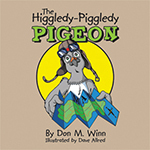 The Higgledy-Piggledy Pigeon: An ambitious pigeon discovers that having a learning challenge can’t stop him from succeeding. An inspiring story for anyone who deals with a learning challenge!
The Higgledy-Piggledy Pigeon: An ambitious pigeon discovers that having a learning challenge can’t stop him from succeeding. An inspiring story for anyone who deals with a learning challenge!
A Mom’s Choice Award Recipient
“The story reminds parents that while children may develop certain learning skills more slowly than others do, they are not necessarily limited for life. As Winn says in the Introduction, ‘Albert Einstein couldn’t read `til he was nine, but look what he accomplished once he did!’” —Nancy O. Nelson, PhD.
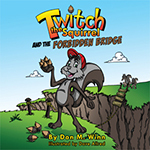 Twitch the Squirrel and the Forbidden Bridge: Twitch finds out that his parents have good reasons for the rules they make. An exciting tale that shows kids the importance of following the rules.
Twitch the Squirrel and the Forbidden Bridge: Twitch finds out that his parents have good reasons for the rules they make. An exciting tale that shows kids the importance of following the rules.
A Mom’s Choice Award Recipient
“A colorful illustrated teaching story about the importance of respecting parents’ rules told in jaunty, narrative verse, which helps drive further its appealing and exciting moral to a young childhood audience.” —Midwest Book Review
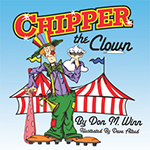 Chipper the Clown: Chipper learns that in order to follow his dreams, he needs to ask for help. An encouraging story for anyone wishing to learn a new skill!
Chipper the Clown: Chipper learns that in order to follow his dreams, he needs to ask for help. An encouraging story for anyone wishing to learn a new skill!
Mom’s Choice Award Recipient
“A wonderful story to share with children to remind them that their dreams are valid and they should be followed…but sometimes we may have to work a wee bit harder than we expected.” —The IE Mommy, “Christine”
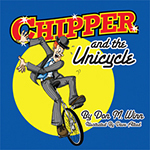 Chipper and the Unicycle: after searching the world for a new act, Chipper learns the importance of perseverance. A fun story that teaches young readers the importance of determination!
Chipper and the Unicycle: after searching the world for a new act, Chipper learns the importance of perseverance. A fun story that teaches young readers the importance of determination!
A Mom’s Choice Award Recipient
“This rhythmic story teaches children the benefits of trying hard and practicing to reach a goal or learn a new hobby. In today’s society, this is an important lesson to learn in a FUN story about a clown!” —Cecilie Mann Engle
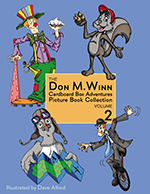 The Don M. Winn Cardboard Box Adventures Picture Book Collection Volume Two: Four great Cardboard Box Adventures picture books in one volume!
The Don M. Winn Cardboard Box Adventures Picture Book Collection Volume Two: Four great Cardboard Box Adventures picture books in one volume!
Includes:
• The Higgledy-Piggledy Pigeon
• Twitch the Squirrel and the Forbidden Bridge
• Chipper the Clown
• Chipper and the Unicycle
Where to Buy
The Sir Kaye chapter books and the CBA picture books are available in softcover, hardcover, and eBook formats from Amazon, Barnes and Noble, Amazon Canada, and Amazon UK. Select titles are also available as audio books from Audible. Up to 40% bulk discounts are available directly from the publishers. For bulk discounts on the Sir Kaye books, contact Progressive Rising Phoenix Press. For bulk discounts on the CBA picture books, please email Don Winn with an inquiry.


October 28, 2016
Legend of the Forest Beast Wins Moonbeam Award
I’m thrilled to announce that Legend of the Forest Beast, the third book in the Sir Kaye the Boy Knight series of chapter books has won the silver medal in the pre-teen general fiction category of this year’s (2016) Moonbeam Children’s Book Awards.
The series follows the exploits of Sir Kaye, a twelve-year-old knight in the fictional medieval land of Knox, as he tries to prove he is worthy of his early knighthood and to find his place in the world. Along the way he and his best friends, Reggie and Beau, encounter thrilling adventures, which they face with courage, loyalty, and a lot of ingenuity.
Legend of the Forest Beast finds Kaye, Reggie, and Beau on their first adventure outside the queen’s castle. On a quest to find their missing tutor, they find themselves attempting to infiltrate a mysterious manor house on the edge of a sinister forest where nearby villagers live in terror of a deadly monster. As they investigate the mystery of the forest beast, they uncover a terrible plot that could destroy Knox. When there’s no one to turn to for help, can they save the kingdom—and their lives—by themselves?

This is the second medal from the Moonbeam Children’s Book Awards for the Kaye series, since book one, The Knighting of Sir Kaye, also received the silver medal back in 2013.
The Moonbeam Awards recognize the year’s best children’s books and are chosen by judging panels of book reviewers, librarians, teachers, and students. “This year’s winners are more diverse than ever, with inspiring messages that encourage kids to be kind, courageous, and to live healthy lives,” says Awards Director Jim Barnes.
Each of the 159 medalists possesses a distinctive quality that motivated the judges to award them amongst fierce competition, 1,500 entries in all.


October 19, 2016
A Window Into Your Child’s Mind

Have you ever wished you had a window into your child’s heart, mind, or soul? I think most parents have. At times, children can do or say things that seem so unexpected, so foreign, so cryptic or inscrutable, that we might wish we had access to one of those Universal Translator devices from Star Trek. Since all humans tend to interpret events through the lens of their own experiences, it can be difficult to imagine that another person might experience a situation in a completely different way from our own interpretation. And yet that is exactly what happens. Everyone’s reality is their very own. Including that of a child.
So what’s a parent to do?
Start by noticing pursuits that isolate your child in their own insular, inner world, and then make some substitutions with activities you can do with your child. Shared experiences allow you to observe how your children respond, offering that precious window into the way their brains works, how they process things, and what kinds of stimuli really ping their consciousness.
Be prepared to be surprised.
Don’t get me wrong: you can definitely make the case that the internet and the plethora of readily available electronic devices have their benefits. I often marvel at how the whole world is now at our fingertips. Technology has definitely revolutionized how we see the world. However, along with the benefits, there’s also a potential downside, if technology is not kept in its place. Today, more and more children spend so much time in front of the TV, computer, and/or other electronic devices that they rarely see the real (non-simulated) world.
This brings to mind a salient quote by Geneen Roth, “The true disaster is living the life in your mind and missing the life in front of you.” For many kids today, living life has become synonymous with being attached to an electronic device. (And maybe for some parents too.)
Depending on where you live, there are generally many opportunities to put away electronics and explore the world without having to travel very far. For instance, when was the last time you’ve gone to a zoo? Or a museum? Sometimes there are often overlooked attractions in your own backyard, so to speak. Does your town have any historical areas, museums, points of interest, animal rescue groups? Most do. Going on nature walks right in your own neighborhood is a no-cost option.
But what if going to a zoo or to a museum of any kind doesn’t seem to appeal to your child? You can find ways to make it more appealing. For instance, what kinds of things is your child really interested in? How about your child’s favorite animal? You can then plan a trip to the zoo or museum or some other attraction with your child’s interests in mind.
My wife and I recently took a trip to the San Antonio Zoo and San Antonio Art Museum with a young friend of the family who is like family to us and who loves art. Her name is Chandler. Not only did we all thoroughly enjoy ourselves, but we learned some fun, interesting things in the process. These experiences offered a window into our young friend’s mind that was surprising, entertaining, and delightful. Making the effort to find out what a child is thinking is one of the best investments of a parent’s (or an honorary aunt’s and uncle’s) time.

At the zoo, one of the highlights was getting to hand-feed little parrot-like birds called Lories, and we all really enjoyed the giraffes (especially the babies) and the underwater views of hippos lazing in the water.

But afterward, when talking with Chandler about what she enjoyed the most, some of her answers were surprising. Chandler enjoyed people-watching and seeing their reactions to the animals. She made special mention of the Betsey Johnson and Michael Kors purses, to the point of the count she had made of each. (I didn’t even know who those people are!) She also said that she felt like she could watch the giraffes “forever.” The butterfly exhibit wasn’t a temptation for her, nor was the reptile house, but she liked the anacondas.

Even our trip to a grocery store was entertaining: while investigating the bulk bin aisle, as Chandler was selecting some lollipops she liked, I asked her what the difference was between a sucker and a lollipop. Her reply? “One is less dignified.” That spontaneous bit of humor gave all of us a good laugh.
I would have to say that the art museum was our favorite part of the day. We saw a lot of beautiful paintings, sculptures, pottery and many other works of art from around the world. Although we enjoyed much of it in silence together, there were opportunities to talk about some of the pieces. Again, some things were surprises.
All three of us loved a painting by American artist Seymour Joseph Guy (1824-1910), called A Bedtime Story. I asked Chandler what she specifically liked about it, and she said she could see herself being the older girl in the picture reading the stories to the children. When I looked at the same painting, I saw myself being on the receiving end of the stories. I wanted to be the little kid enjoying the story!

The artwork/craftsmanship of the palanquin, or norimono also impressed us all. A palanquin is a wheel-less conveyance for transporting the wealthy or privileged. It was carried at two ends of a central beam on the shoulders of four to six men. Chandler was captivated by it, and by imagining what it would be like to ride in one. The look on her face spoke of the imagination of a true romantic. Another window to her interior world!

A trip to a bookstore offered more glimpses: home decorating books, cookbooks, and marine biology tomes were the favorites.
On the ride home, the three of us played a game asking each other questions, such as:
What did you enjoy most about today?
What’s one thing about today that you wish were different?
If you could trade places with someone for one day, who would it be?
What was your best day ever?
By sharing experiences together, and showing genuine interest in what children liked (and didn’t), we can begin to acquaint ourselves with the individuals each young one is growing to become. There’s a window into each child’s personality, heart, and soul, and if we make the time to be present with them and pay attention, our lives and theirs will be the richer for the endeavor.


October 6, 2016
The Precious Gift of Reading
 I had the privilege of giving a speech in Georgia earlier this month at this year’s Decatur Book Festival (September 3, 2016). I spoke about the challenge that learning to read presents to children with learning differences such as dyslexia, and how we, as parents and educators, can help such children to develop a love of story. A very appropriate quote from Kate Di Camillo highlights this teaching approach to students: “Reading should not be presented to children as a chore or duty. It should be offered to them as a precious gift.”
I had the privilege of giving a speech in Georgia earlier this month at this year’s Decatur Book Festival (September 3, 2016). I spoke about the challenge that learning to read presents to children with learning differences such as dyslexia, and how we, as parents and educators, can help such children to develop a love of story. A very appropriate quote from Kate Di Camillo highlights this teaching approach to students: “Reading should not be presented to children as a chore or duty. It should be offered to them as a precious gift.”
The sad truth is that many children view reading as a chore because of learning difficulties. How can such children be helped to see reading as a gift?
As a dyslexic, I know what it’s like to struggle to read. My grandmother spent time with me, reading with me, and helped me develop a love of great stories. That exposure to the wonder of books planted a new awareness in my brain, a thought that said, “even though reading is so hard, these stories are wonderful”! I wanted more. The reward of stories made the effort of reading worthwhile, and that love of story is what helped me persevere as a reader, and now as a writer, although reading and writing will never be effortless for me.
As a kid, reading stories helped me see myself differently. That was important, since nearly all of us who are dyslexic, or who struggle otherwise to learn, judge ourselves harshly. We compare ourselves to our peers who seem to learn with little or no effort, and unfortunately, we can gain the impression from even well-meaning educators that we’re unmotivated, stupid, slow, or lazy.
But when I was immersed in a story with characters who had feelings like mine, or who struggled with challenges like mine, I learned that I wasn’t the only person who felt the way I did. It gave me hope to see that others could meet challenges and do difficult things and believe in themselves. That meant that there was hope for me!
Little did I know that I was encountering what’s called in psychology a “hero of self-reference.” While there weren’t any stories about people with dyslexia when I was a kid, reading about people who dealt with other struggles served my need to feel like I wasn’t that different from everybody else. Through stories, I learned that struggle is nothing to be ashamed of.
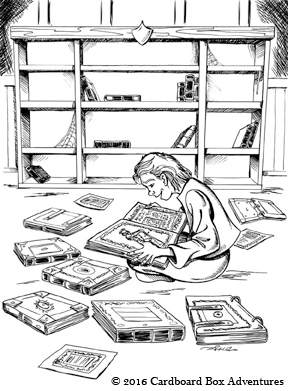 Today, at-risk readers and dyslexics are rarely presented with successful depictions of characters like themselves. And while I write to entertain all my readers, there’s a special place in my heart for struggling students who can’t imagine themselves ever being a good reader. I want them to see heroes of self-reference uncovering hidden strengths, dealing with their feelings and the frustrations of their own situations. I want kids to learn that if they need to do things differently to get the job done, that’s a strength, not a weakness.
Today, at-risk readers and dyslexics are rarely presented with successful depictions of characters like themselves. And while I write to entertain all my readers, there’s a special place in my heart for struggling students who can’t imagine themselves ever being a good reader. I want them to see heroes of self-reference uncovering hidden strengths, dealing with their feelings and the frustrations of their own situations. I want kids to learn that if they need to do things differently to get the job done, that’s a strength, not a weakness.
Once kids actually learn to read, then, for the rest of their life, they read to learn. Reading still provides the largest educational platform. That means that for the tens of thousands of folks out there who never learn to read well, their learning opportunities diminish dramatically at a very young age.
If I had never begun to think of myself as a reader, I would have never become a learner.
I write books so at-risk readers can begin to think of themselves as readers and learners, full of potential and strength.
We can all look for opportunities to read to kids more often and thereby strengthen their love of a great story. When we are patient with them, helping them sound out words, asking questions about the story to discern what they’ve understood, we show faith in them as people. We demonstrate that we believe they can be good readers and students. Sometimes we need other people to believe in us first, before we can learn to believe in our own potential.
In conclusion, I offer the following quote by Katherine Patterson, “It is not enough to simply teach children to read; we have to give them something worth reading. Something that will stretch their imaginations—something that will help them make sense of their own lives and encourage them to reach out toward people whose lives are quite different from their own.”


September 22, 2016
A 40-year-old Message to Parents from…LEGO?
HuffPost Parents offered up a real jewel recently. The article was a wake-up call, a call to action for parents. It focused on, of all things, a package insert from a toy whose message hailed from the 1970’s. It was something that may have been discarded without a thought, but instead proved to be quite forward-thinking and profound.

Daniel Fry discovered the insert while he was playing LEGO with his niece and nephew at their great-grandmother’s house. The makers of the iconic (and still current) toy line from LEGO wrote that package insert to parents back in 1974, over 40 years ago. Its message?
The Letter Reads:
“To Parents
The urge to create is equally strong in all children. Boys and girls. It’s the imagination that counts. Not skill. You build whatever comes into your head, the way you want it. A bed or a truck. A dolls’ house or a spaceship. A lot of boys like dolls’ houses. They’re more human than spaceships. A lot of girls prefer spaceships. They’re more exciting than dolls’ houses. The most important thing is to put the right material in their hands and let them create whatever appeals to them.”
What can we as parents learn from this? There’s quite a bit of good food for thought in that short paragraph, actually.
Humans are ever-so-prone to categorizing things, (and people) all too frequently. We may tend to think of the color blue and trucks for boys, and pink toy strollers with dolls inside for little girls.
When we contain someone within a box that says, “these are your boundaries for creativity, nothing else is acceptable,” we run the risk of stifling personal expression and stunting imagination. Of course I’m not suggesting that there should be no boundaries at all: disrespect for personal property, injuring self or others, and dishonesty, for example, are all frowned upon in most world societies.
Even worse, by predetermining creative boundaries for children, we send a message that if they want something outside those boundaries, there is something fundamentally wrong about them. Something wrong with who they are. That creates shame. And nothing is more toxic than shame.
Imagination DOES count. Imaginative play in childhood lays the groundwork for problem-solving skills we require in adulthood.
When kids feel free create whatever they imagine, the way they want it, it gives them a sense of control. Kids who grow up with a good sense of what control feels like are less likely to go through life feeling like helpless victims.



September 8, 2016
What Makes a Parent Successful?

Success can be defined in so many ways—politicians can count the number of votes received, schools can prove how many kids passed a standardized test, businesses can track sales. Some people may see beyond those definitions, and there is certainly a lot more to success than the simplistic notions above. But defining successful parenting is even trickier.
I read an article published recently on the MindShift website. It was entitled “If School is not Relevant“ and it posed some thought-provoking questions about the effectiveness of schools in teaching children to succeed.
The author, Shelley Blake-Plock, an educator himself, encourages us all to redefine success as an achievement inclusive of failures. “Because we are all failures of one sort or another. And though we like to focus on what we consider positive, it is more often the case that we live in a world comprised of systems of struggle and unanswerable questions. And we fail on a regular basis. And we need students who understand how to fail.”
He states: “Imagine if schools were judged not by how well students achieved while they were in school, but in how well they achieved once they left. If schools saw their worth not in how many kids got accepted to college, but in how many kids went on to live meaningful and engaged lives and who would point back to their school years as the point of relevancy that was the foundation of it all. If schools gauged themselves not by how many kids passed a test, but in how well it prepared those kids who did not pass the test to see themselves as worthy of respect and ready to take on the challenges of life. In fact, if schools worked to make entrepreneurs and role models of every kid who failed a standardized exam. If failure became a calling card for innovation.”
He continues: I want to hear from the kids for whom school didn’t work. I want to hear from the alumni who feel cheated by the system. I want our schools to be judged by how well we respected the humanity of the student who graduated with the lowest GPA and how we celebrated and engaged his or her capacity within society.
Those questions caught my attention, and I’ve adapted three of them (freely) to apply to parents. Why to parents? Because family is a child’s first school and source of life skills. Here they are:
What if parents gauged their success, not by how well their kids are provided for financially, but in how well prepared their kids are to take on the challenges of life?
What if our unshakeable belief in the humanity of our own child (even if/especially when they are very different from us) was the single greatest impetus for them to finally believe in themselves?
What if our kids can point to the time we spent with them and the values we taught them as the reason for their success?

When children are young, one of the best ways parents can spend time with them is reading aloud and talking about what has been read. Here are two ways to enrich your conversations with your children about books you’ve read together:
Ask questions about what happened in the story: Asking children questions about what they’ve read teaches them how to reason and helps them develop common sense and logic, both valuable tools for taking on the challenges of life. It helps them learn to put thoughts and feelings into words. Asking for their observations teaches them to trust their own insights, and that those insights are interesting to us as their parent.
Ask questions about what didn’t happen in the story: Questions about details that are not specifically mentioned in a story teach children to use their imaginations to project their ideas beyond what is known and to draw conclusions that make sense based on the details they already know. This can help them become creative problem-solvers as they develop intuition and the ability to make logical inferences—another great way to help children prepare for the challenges of life.
Begin laying the foundation now for your child’s best life. Read together. Find out what they’re thinking and feeling. You won’t regret it.


August 24, 2016
Undoing Stinkin’ Thinkin’ Part Two: Helping Children
 In our world, competition has never been keener. Personal worth is measured almost exclusively by judging people’s accomplishments and acquisitions. Unfortunately, the same yardstick is also used to measure our children. And children, like the sponges that they are, are quick to absorb that judgmental subtext. They pick up the torch by comparing themselves to others, which only compounds their situation. In any given environment, there will always be someone (or more than one someone) who is better at math, spelling, drawing, reading, music, has better hair, better personal skills, fewer freckles, no braces, better rhythm, or better clothes.
In our world, competition has never been keener. Personal worth is measured almost exclusively by judging people’s accomplishments and acquisitions. Unfortunately, the same yardstick is also used to measure our children. And children, like the sponges that they are, are quick to absorb that judgmental subtext. They pick up the torch by comparing themselves to others, which only compounds their situation. In any given environment, there will always be someone (or more than one someone) who is better at math, spelling, drawing, reading, music, has better hair, better personal skills, fewer freckles, no braces, better rhythm, or better clothes.
It’s the perfect storm which can cause a child to shipwreck themselves: a foundation of beliefs surrounding personal worth where recognition of effort, courage, love, and compassion do not even enter into the equation.
I mentioned Brené Brown’s important work in Part 1 of this topic, and it has a bearing here as well. Her work helps parents reverse unhealthy belief systems that children may already have formed, and prevent them from becoming a lifelong personal truth.
She recounted an event that touched her and informed her parenting, a Toni Morrison interview she saw on television. “Ms. Morrison explained that it’s interesting to watch what happens when a child walks into a room. She asked, “Does your face light up?” She explained, “When my children used to walk in the room when they were little, I looked at them to see if they had buckled their trousers or if their hair was combed or if their socks were up. . . . You think your affection and your deep love is on display because you’re caring for them. It’s not. When they see you, they see the critical face. What’s wrong now?” Her advice was simple, but paradigm- shifting for me. She said, “Let your face speak what’s in your heart. When they walk in the room my face says I’m glad to see them. It’s just as small as that, you see?” (1)
Moved by that experience, and by her engagement with humanity through her shame research, Dr. Brown wrote “The Wholehearted Parenting Manifesto.” She says, “I use the manifesto as a touchstone, a prayer, and a meditation when I’m wrestling with vulnerability or when I’ve got that “never enough” fear. It reminds me of a finding that changed and probably saved my life: Who we are and how we engage with the world are much stronger predictors of how our children will do than what we know about parenting.”

These parental responses teach kids object lessons in the most powerful way: by modeling healthy belief systems for our kids.
When we model compassion toward ourselves, kids see how it’s done and the benefits it brings.
When our face lights up each time we see them, they learn that they are deeply loved and lovable.
When we recognize their efforts, not just the results, they feel validated and motivated to keep working hard.
Sharing stories of struggle and strength (both our experiences and theirs) create the potting soil in which true courage is rooted.
When our kids see us make amends for our mistakes, they learn accountability and respect.
Modeling perseverance—referred to as ‘grit’ in her book “Rising Strong,” teaches kids how to keep going even when things go awry.
Rather than aiming for the unreachable parental desire to take away our child’s pain, we can teach them how to feel it, how to respond to it, and how to determine what comes next after a failure or a disappointment.

These techniques are important for all young ones, but are especially crucial when parenting a child who struggles to learn.


August 17, 2016
Undoing Stinkin’ Thinkin’ Part One: Adults

If I were a betting man I’d wager that there isn’t one person out there that doesn’t have some kind of negative baggage from their childhood, in varying degrees. Struggling with dyslexia and coming from a broken home, I’ve had to get a sidecar for my negative baggage. Ok, two sidecars. Confessions aside, the point is that these negative experiences create beliefs about ourselves, what we deserve, what we can or can’t do, whether it’s safe to trust others, and whether we are lovable or not, to name a few. The biggie, underpinning all these fears and negativity, is our human vulnerability: the deep-seated fear that if anyone ever knew the REAL us, flaws and all, we would be abandoned. (Hat tip to Brené Brown, psychologist extraordinaire.)
Strange as it may seem, there is a positive (though misguided) intention to our negative thoughts.
You see, our brains are actually hardwired for negativity as a defense mechanism. Like allergies, where our immune system overreacts to innocuous pollen and other harmless substances, the amygdala, the part of our brain where negative thoughts originate, generates negative thoughts to protect us from getting hurt. By imagining scenarios of the worst sort, and lowering our expectations of self or others, we may subconsciously feel braced for the inevitable disappointment we’re sure we’ll always experience. (1)
This reminds me of the Mark Twain quote, “I’ve lived through some terrible things in my life, some of which actually happened.”
Well, that’s interesting, but what can I do about my negative thoughts, you ask? Great question!
Recognize that most of our stress and distress comes from our own mind and beliefs. Each person has an average of 60,000 thoughts a day. That’s one thought per second in every waking hour! Amazingly, 95 percent are the same thoughts repeated every day. On average, 80 percent of those habitual thoughts are negative. (2) But what seems like a comfort zone, our own personal status quo, is actually a discomfort zone.
Notice negative thoughts and the beliefs that underpin them when they arise, and breathe deeply while observing them like a scientist. Notice the word ‘observe’, not ‘judge’.
Recognize that thoughts and feelings are not facts. While we usually experience our thoughts as facts, by learning to experience them as passing mental events, they have less power to keep us stuck in old beliefs.
This switch, the shift from perceiving thoughts as facts to perceiving them as passing mental events, can create a feeling of a void in the brain that can seem scary, unknown. Kind of a “Who am I without this familiar story of myself?” phenomenon. But that void isn’t a scary thing at all, in reality: in reality, a void is simply a clean space that’s ready to be filled with anything we choose to put in it. A void is a sacred space.

Just as cleaning out a closet full of old clothes that never suited us and were never worn creates space for the things that we love to wear now, so too embracing that space in our brain recently vacated by old beliefs that don’t serve our needs allows us to stop identifying with past failures, and to embrace the ability to see ourselves succeeding.
Research tells us the best way to deal with thoughts we don’t want to think or feelings we don’t want to feel is to just accept that they happen. They happen to every human. Acknowledge that you don’t have control over whether a thought or emotion comes up, and realize that the more you hate yourself or the thought, the stronger its influence becomes. Even though you can’t control what comes into your mind, you don’t need to focus on it and ruminate on it.
Start to see these thoughts, memories, and emotions that come up like a wave that rises, crests, and then subsides on its own. You don’t suppress it, push it away, dive into it, or otherwise interact with it. You just watch the wave and wait it out. (Remember, observe, don’t judge.) S. Bowen and A. Martlett call it ‘surfing the urge’ in the 2009 book, Psychology of Addictive Behavior. Though this technique is designed specifically for those in recovery from addiction, the exercise works well for anxiety and negative thinking patterns as well. (3)

Conclusion: Since so many of my readers are dyslexic or parents or teachers of dyslexic children, Part 2 of this article will offer specific suggestions to help young ones deal with their stinkin’ thinkin’ about themselves.
Source Links:
(1) http://www.amenclinics.com/blog/why-are-we-so-negative/
(2) http://www.clevelandclinicwellness.com/programs/NewSFN/pages/default.aspx?Lesson=3&Topic=2&UserId=00000000-0000-0000-0000-000000000705
(3) http://www.drugrehab.org/expert-area/urge-surfing-mindfulness-techniques-to-prevent-relapse/


August 4, 2016
Sir Kaye in the Classroom!
 Teachers and educators will be excited to learn that there are now lesson plans and activities to help incorporate the Sir Kaye series of medieval adventure chapter books into the classroom. The lesson plans can be easily adapted for homeschooling activities as well. Each lesson plan is designed to help the young reader to look beyond the story, investigate the characterizations more deeply, and to foster critical thinking skills.
Teachers and educators will be excited to learn that there are now lesson plans and activities to help incorporate the Sir Kaye series of medieval adventure chapter books into the classroom. The lesson plans can be easily adapted for homeschooling activities as well. Each lesson plan is designed to help the young reader to look beyond the story, investigate the characterizations more deeply, and to foster critical thinking skills.
Below is a brief summary of the lesson plan for each book. The full lesson plans are available for download (http://www.donwinn.com/resources.html) and in addition, you’ll find supplementary material about life in the middle-ages with lots of fun facts.
Sir Kaye Book 1 Lesson Plan Summary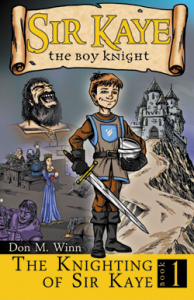 Sir Kaye the Boy Knight Book One: The Knighting of Sir Kaye paired with the Book 1 Lesson Plan will make a great addition to your curriculum. Apart from being a fun and engaging story that will help instill a love of reading in your students, Sir Kaye is a great introduction to Medieval themed literature. While children are expanding their vocabulary and spelling skills, this book, along with the lesson plan, is designed to teach kids important life lessons that will help them in and out of the classroom. The lesson plan is broken into three parts, each focusing in on a central theme from the story that the students will be able to apply to their own lives. These themes include the importance of bravery, the proper way to deal with jealousy, and how pride can hinder people from doing the right thing. The Knighting of Sir Kaye is a story your class will love
Sir Kaye the Boy Knight Book One: The Knighting of Sir Kaye paired with the Book 1 Lesson Plan will make a great addition to your curriculum. Apart from being a fun and engaging story that will help instill a love of reading in your students, Sir Kaye is a great introduction to Medieval themed literature. While children are expanding their vocabulary and spelling skills, this book, along with the lesson plan, is designed to teach kids important life lessons that will help them in and out of the classroom. The lesson plan is broken into three parts, each focusing in on a central theme from the story that the students will be able to apply to their own lives. These themes include the importance of bravery, the proper way to deal with jealousy, and how pride can hinder people from doing the right thing. The Knighting of Sir Kaye is a story your class will love
for years to come and the takeaways from the story will stay with them even longer.
Sir Kaye Book 2 Lesson Plan Summary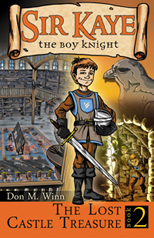 Sir Kaye the Boy Knight Book Two: The Lost Castle Treasure is a suspenseful and mysterious story that is sure to keep your students on the edges of their seats from beginning to end. Paired with its lesson plan, it’s the perfect book to introduce your class to new creative writing techniques. In the daily lessons, students are introduced to the idea that there are many ways to express emotion through writing and actions. Drawing from the text and through engaging role play, your class will learn to think creatively about different ways emotions can be conveyed. Once they have grasped this idea, students are challenged to write their own sentences describing feelings, which works to drive home the lesson and inspire classroom creativity. The Lost Castle Treasure is sure to reveal the creative excitement that reading and writing provide.
Sir Kaye the Boy Knight Book Two: The Lost Castle Treasure is a suspenseful and mysterious story that is sure to keep your students on the edges of their seats from beginning to end. Paired with its lesson plan, it’s the perfect book to introduce your class to new creative writing techniques. In the daily lessons, students are introduced to the idea that there are many ways to express emotion through writing and actions. Drawing from the text and through engaging role play, your class will learn to think creatively about different ways emotions can be conveyed. Once they have grasped this idea, students are challenged to write their own sentences describing feelings, which works to drive home the lesson and inspire classroom creativity. The Lost Castle Treasure is sure to reveal the creative excitement that reading and writing provide.
Sir Kaye Book 3 Lesson Plan Summary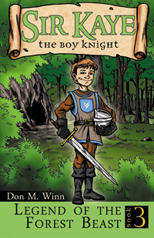 Sir Kaye the Boy Knight Book Three: Legend of the Forest Beast is another adventurous installment in a series portraying complex and relatable characters that teaches kids that they are capable of doing great things. Combined with the lesson plan, it’s a fun way to teach students the importance of humility and to challenge their creative and objective writing skills. The lesson plan is divided into three parts, each beginning with fun trivia questions to test kid’s reading comprehension skills. Next, each segment provides fun and helpful activities such as creating fictional characters, becoming a Royal Chronicler for the day and writing about the goings-on of the classroom, and having a comprehensive discussion about what humility looks like in day-to-day life. In addition, the lesson plan provides daily vocabulary activities to help students fully understand the story and improve their dictionary and writing skills. Legend of the Forest Beast and its lesson plan are sure to heighten your student’s creativity and provide them with tools that will help them in and out of the classroom.
Sir Kaye the Boy Knight Book Three: Legend of the Forest Beast is another adventurous installment in a series portraying complex and relatable characters that teaches kids that they are capable of doing great things. Combined with the lesson plan, it’s a fun way to teach students the importance of humility and to challenge their creative and objective writing skills. The lesson plan is divided into three parts, each beginning with fun trivia questions to test kid’s reading comprehension skills. Next, each segment provides fun and helpful activities such as creating fictional characters, becoming a Royal Chronicler for the day and writing about the goings-on of the classroom, and having a comprehensive discussion about what humility looks like in day-to-day life. In addition, the lesson plan provides daily vocabulary activities to help students fully understand the story and improve their dictionary and writing skills. Legend of the Forest Beast and its lesson plan are sure to heighten your student’s creativity and provide them with tools that will help them in and out of the classroom.
Sir Kaye Book 4 Lesson Plan Summary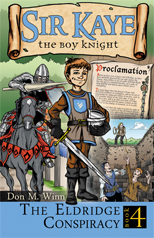 Sir Kaye the Boy Knight Book Four: The Eldridge Conspiracy and Lesson Plan will be available in 2017.
Sir Kaye the Boy Knight Book Four: The Eldridge Conspiracy and Lesson Plan will be available in 2017.
The Sir Kaye titles are available for significant discounts to schools, libraries, non-profits, retailers, and vendors through Progressive Rising Phoenix Press or Ingram/LSI. For media requests or event bookings, please contact us.
Author visits are available in person and via Skype. Contact Don Winn at author@donwinn.com about readings, presentations, workshops, and Q&A sessions, adapted according to age or special needs. Ask about a special Sir Kaye presentation about medieval life, including a Q&A with the students.


July 26, 2016
Official Release: Legend of the Forest Beast (K3)!
The third installment in the Sir Kaye, the Boy Knight series, Legend of the Forest Beast, is finally ready! I’m pleased to announce that Legend of the Forest Beast is now available from Amazon.com and other online retailers.
So what can you expect with book 3 in the Sir Kaye series? To answer that question I’ve included the official K3 press release and an early review from the UK Wishing Shelf Awards.
Check out the About the Sir Kaye series page for a preview of all three books in the award-winning Sir Kaye series and links to purchase.
The Sir Kaye titles are available for significant discounts to schools, libraries, non-profits, retailers, and vendors through Progressive Rising Phoenix Press or Ingram/LSI.
Here’s the official K3 press release:
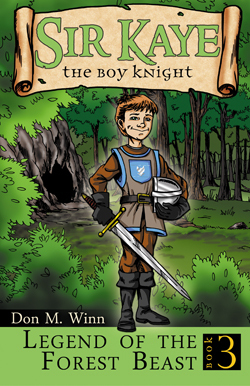
New children’s novel teaches humility and bravery
Don M. Winn’s new illustrated chapter book, Legend of the Forest Beast, continues the award-winning tradition of the Sir Kaye series with another adventure that will keep readers guessing until the very end.
July 26, 2016, Austin, TX—Legend of the Forest Beast, the third novel by award-winning children’s book author Don M. Winn, is now available. The anticipated third installment to The Sir Kaye series—Winn’s award-winning collection for middle readers, features a twelve-year-old knight that captivates young readers with its complex characters and beautiful illustrations.
Continuing the saga of Sir Kaye, this fast-paced adventure has best friends Kaye, Reggie, Beau and their community worried for the safety of the beloved tutor, Alchir. Their search for Alchir leads the boys to a manor house at the edge of a dark forest where nothing is what it seems. A legend of a deadly forest beast keeps the nearby citizens living in fear, but is the beast real, or are the mysterious events in the area the result of something else entirely? Read this fun adventure, highlighting bravery, humility, all-important aspects of success and friendship, to find out!
Revealing new depths to familiar characters, Legend of the Forest Beast continues to add to the richness of the series. Eager to make a name for himself, Kaye struggles to keep his sight on accomplishing his mission and learns to sacrifice his pride for the good of those around him. And it’s Kaye’s best friend Reggie’s quick thinking that saves Kaye from a deadly situation without adding more violence to a volatile situation. The story also introduces Layla, a fiery and outspoken girl whose intelligence and wit are often mistaken for rudeness. However, through her complex character, young readers learn not to judge people too quickly and to try to see what really motivates a person to act the way they do. Legend of the Forest Beast is a story about looking beneath the surface of others, oneself, and learning to focus on what’s most important.

Legend of the Forest Beast Advance Review from The UK Wishing Shelf Awards Reviews:
“A cracking, fun-filled adventure. Highly recommended!”
I do enjoy a good adventure and this is what this is. Don Winn, the author, has plotted a fun and, often, very exciting children’s novel. But not only that, he’s given the reader an array of interesting characters to follow and framed everything in an accessible style of writing.
Now, this book is the third in the set but don’t worry. I have not read the first two but it did not hamper my understanding of who was who and what was happening.
The story opens in the castle hall with the queen asking her knights to protect her tutor, Alchir, from the criminal, Dworfurd. But the meeting is interrupted by the arrival of Alchir’s daughter, Layla, with news her father has already been kidnapped. There then follows a pretty non-stop, well-plotted story with plenty of fighting, nasty criminals and daring knights to keep any young adventure-addict happy.
I was particularly impressed by the style of writing. Many authors tend to describe setting and characters in hefty lumps of text. This might work for adult novels but it can kill a children’s book. Thankfully, this author is wise to this, cleverly mixing up speech, exciting deeds and the describing of character and setting. Subsequently, the writing felt light and not at all like wading through cauliflower-cheese. And, where there is description, it is imaginatively written: “In the dusky hall, his gingery hair looked as brown as mouse fur, but his green eyes shone bright with excitement.”
I was also glad to see there was plenty of comedy in the story, an important aspect of any book for 8 – 12 year olds. Kaye, Sir Griswald, the queen, and in fact, all the knights, were often very, very funny. But, oddly, my favourite character was not a knight, but Layla. She was only a secondary character but she was strong-minded and often very stroppy and I sort of wish she’d had a bigger role to play.
So, would I recommend this story? Yes, absolutely. Any child, approx. 8-12 would love this thrilling story of young knights on a quest for good. In fact, I’d go as far as to say it would make the perfect gift for any reluctant reader (particularly a boy). And, there’s a HUGE cliffhanger at the end so, I’m guessing, Sir Kaye, the boy knight, will be back for another adventure soon.
I always like to finish with the line I loved the most. Well, this is it: “Even asleep, her face wore a scowl.” How fab is that! —A Wishing Shelf Awards Review
Author website: http://www.donwinn.com
Facebook Author page: http://www.facebook.com/authordonwinn
For media inquiries, please contact author@donwinn.com or contact@progressiverisingphoenix.com.





